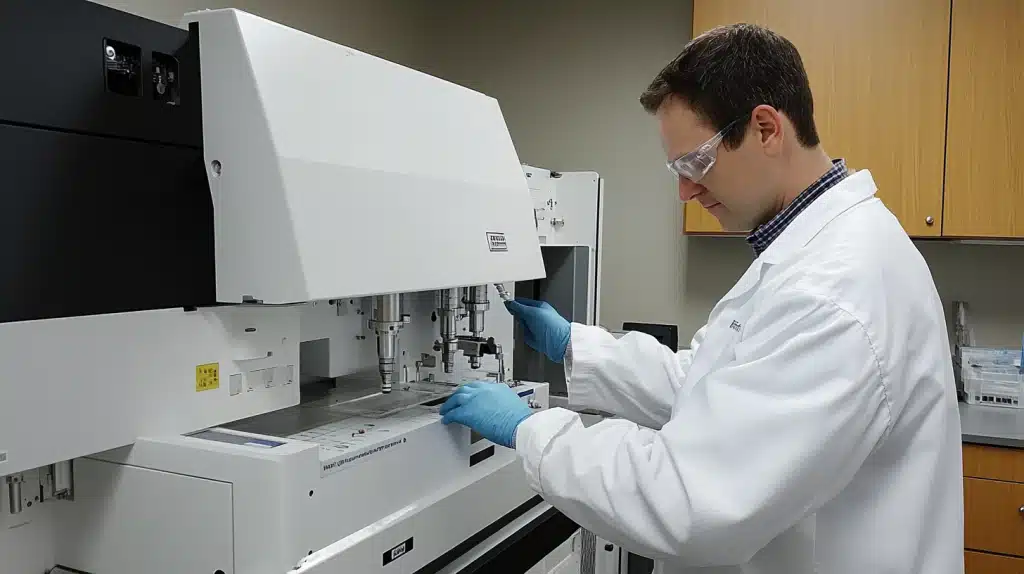Fourier Transform Infrared Spectroscopy (FTIR) is an analytical technique that has revolutionised material identification and chemical analysis. But what is FTIR? Why is it so important? FTIR identifies and studies materials by examining how they absorb infrared (IR) light, producing a unique chemical fingerprint for each sample.
It is widely used across industries and research fields for its precision, speed, and versatility. Whether you’re new to FTIR or seeking a deeper understanding, this guide highlights seven essential facts about this powerful technique.
What Is FTIR?

FTIR stands for Fourier Transform Infrared Spectroscopy, a method that identifies and analyzes materials by examining how they interact with infrared (IR) light. When infrared light passes through or reflects off a sample, specific wavelengths are absorbed depending on the molecular bonds present in the material.
The result is an infrared spectrum that serves as a unique chemical fingerprint of the sample. This technique is essential in fields like pharmaceuticals, food safety, environmental science, and materials research, enabling the identification and quantification of components in solids, liquids, and gases.
How Does FTIR Work?
The process begins with infrared radiation generated by an IR source. This light passes through an interferometer, which splits the beam into two paths—one through the sample and one reflected by a reference mirror.
The beams then recombine, creating an interference pattern that depends on the sample’s absorbance properties. This pattern is processed using a mathematical algorithm called a Fourier Transform to generate the final spectrum. The spectrum represents the material’s molecular vibrations, offering insights into its chemical structure.
What Can FTIR Analyze?
FTIR is one of the most versatile tools in analytical science. It can analyse a broad range of substances across various states:
- Polymers and Plastics: FTIR identifies polymer types, assesses additives, and detects contaminants.
- Pharmaceuticals: It ensures drug quality by analysing active ingredients and excipients.
- Environmental Samples: FTIR monitors air pollutants, assesses water quality, and characterises soil composition.
- Food and Beverages: The technique verifies ingredient authenticity, detects adulteration, and ensures quality control.
This adaptability makes FTIR invaluable in research, development, and routine quality assurance.
Why Is FTIR So Powerful?
Non-Destructive Analysis
FTIR allows for non-destructive testing, meaning samples remain intact after analysis. This feature is particularly valuable when working with rare, precious, or irreplaceable samples.
Rapid Results
Modern FTIR systems are designed for speed, delivering results in seconds. This efficiency is vital for high-throughput environments such as manufacturing quality control labs.
High Sensitivity
FTIR instruments are capable of detecting trace amounts of a compound, even in complex mixtures. This makes it an indispensable tool for environmental monitoring and pharmaceutical testing.
Minimal Sample Preparation
Unlike some analytical techniques that require extensive preparation, FTIR often requires little to no sample treatment. Liquids, gases, and soft solids can be analysed directly, saving both time and resources.
Sample Preparation for FTIR
While FTIR can analyze materials in solid, liquid, or gaseous states, how you prepare the sample can significantly affect the results.
- Solids: These are often ground into fine powders and pressed into pellets or thin films to ensure uniform light transmission.
- Liquids: Liquids are analysed using specialised cells with transparent windows made from materials like NaCl or KBr.
- Gases: Gaseous samples typically require long path-length cells to detect low concentrations.
Careful sample preparation helps ensure accurate and reproducible results, especially for complex materials.
Components of an FTIR Instrument
FTIR instruments comprise several critical components, each contributing to the analysis process:
- Infrared Source: This generates the infrared radiation used in the analysis.
- Interferometer: The core of the FTIR system splits and recombines the light beams to produce the interference pattern.
- Sample Compartment: This holds the material being analysed.
- Detector: The detector captures transmitted or reflected IR light and converts it into an electrical signal, which is then processed to produce the spectrum.
Modern FTIR systems often include software for advanced data analysis, further enhancing their functionality.
Common Applications of FTIR
Quality Control
In manufacturing, FTIR ensures product consistency and detects contaminants in raw materials or finished goods. It is frequently used in industries such as polymers, pharmaceuticals, and food production.
Environmental Monitoring
FTIR plays a vital role in monitoring air, water, and soil quality. It helps identify pollutants and track changes in environmental conditions, providing critical data for regulatory compliance and conservation efforts.
Research and Development
From designing new materials to studying chemical reactions, FTIR is a cornerstone of innovation in materials science, chemistry, and biotechnology.
Forensic Science
In forensic investigations, FTIR helps identify unknown substances, including drugs, explosives, and trace evidence. Its ability to analyse minute samples is especially valuable in criminal cases.
Healthcare and Biomedicine
FTIR is increasingly used in biomedicine to study proteins, lipids, and other biomolecules. It also shows promise in non-invasive disease diagnostics and monitoring.
Limitations of FTIR
Despite its many strengths, FTIR has some limitations.
- Infrared-Inactive Bonds: FTIR can only detect vibrations that cause a change in the dipole moment of a molecule. Symmetrical bonds, such as in O₂ or N₂, do not absorb IR radiation and cannot be analyzed directly.
- Surface Sensitivity: FTIR primarily analyses surface layers, making it less effective for studying bulk material properties.
- Spectral Overlap: In complex samples, overlapping absorption bands can complicate interpretation, requiring additional analysis or expertise.
Understanding these limitations is crucial for obtaining reliable results and integrating FTIR effectively into broader analytical workflows.
Conclusion
FTIR spectroscopy is a powerful analytical tool that combines speed, sensitivity, and versatility. Its ability to analyse a wide range of materials non-destructively makes it indispensable in various industries, from pharmaceuticals to environmental science. By understanding the fundamentals of FTIR and its applications, scientists and engineers can harness their full potential to solve complex analytical challenges and drive innovation in their fields.





















